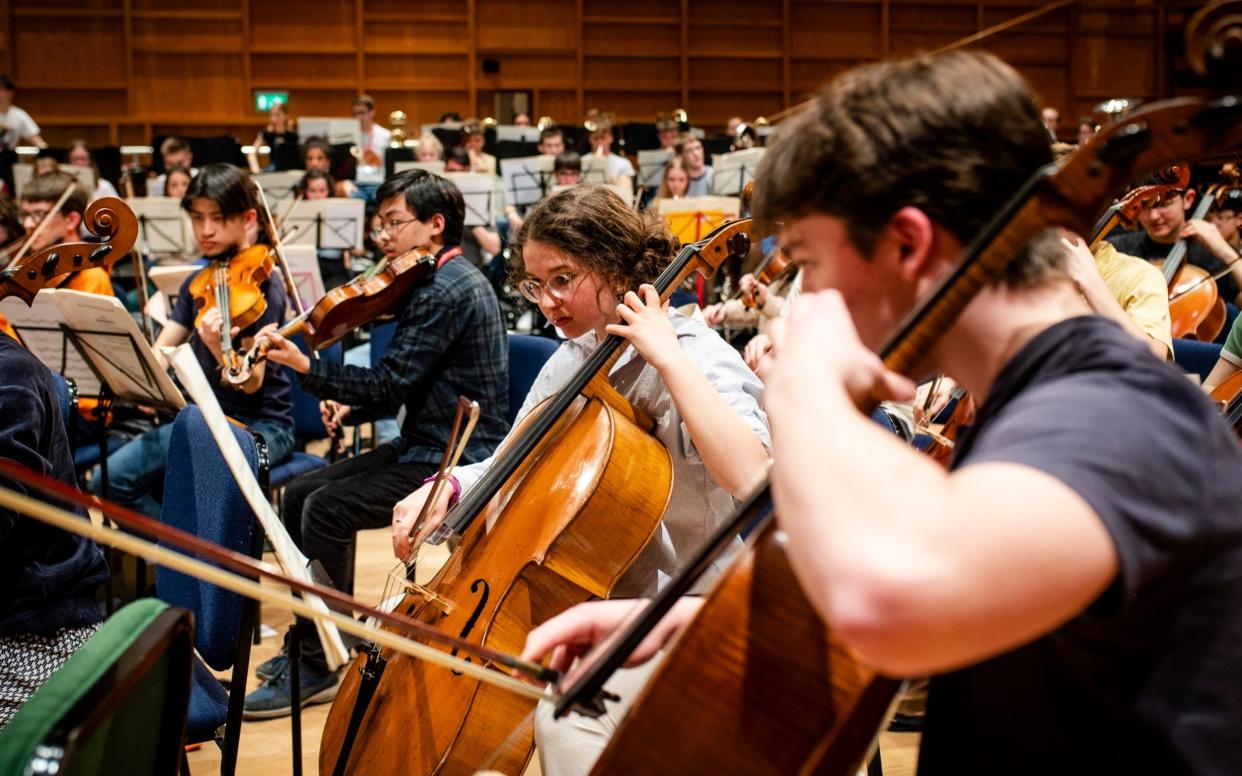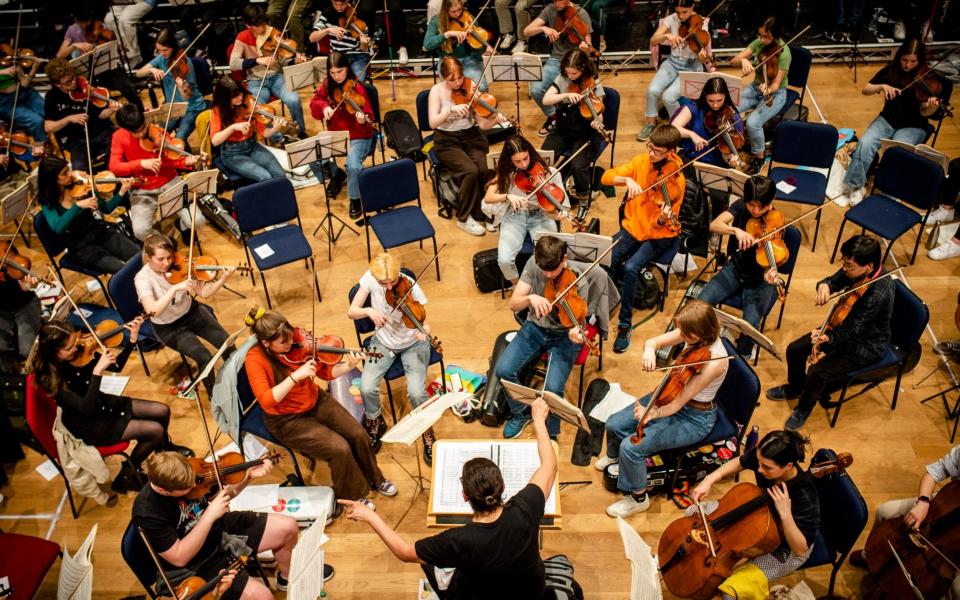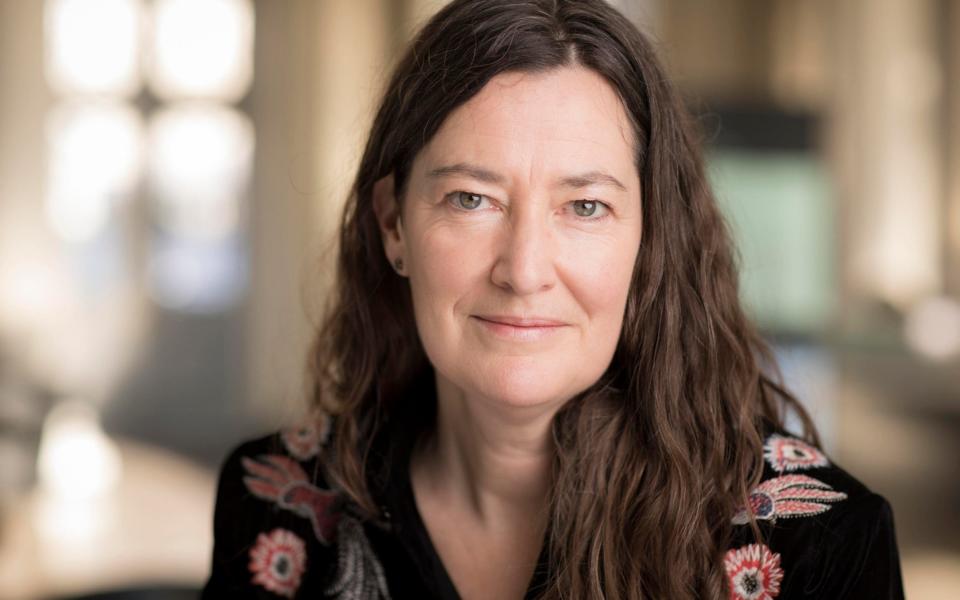The quiet revolution at the National Youth Orchestra

It’s a warm spring afternoon at the campus of the University of Kent, which seems to have undergone a benign musical invasion. Everywhere, there are young people striding about with instrument cases, and as you walk across the green open spaces you hear the unmistakable sound of rehearsing. I step inside one small space and find three tuba players practising the fiendish final bars of Stravinsky’s The Rite of Spring. “ONe-two-ONE-two-three, ONE-two-three” shouts their tutor, beating the irregular bars like mad. When the players finish, the tutor smiles and says, “OKk, but what went wrong?”
There are numerous such busy rehearsal rooms at a National Youth Orchestra residential course, where more than 160 of the best young players in the country come together to practise the hardest classical repertoire, in preparation for a concert at one of the country’s most prestigious venues.
It’s a scene you could have witnessed in any year since 1948, the year the NYO was founded, and you could take it as a comforting indication of stability in a world that seems more than usually unstable. However, look more closely at the NYO and you’ll see unmistakable signs of change. There are more non-white faces among the players than ever before, and the music too is more diverse. The upcoming concert at the Royal Festival Hall has a piece by Mexican composer Gabriela Ortiz and a brand-new concerto for tabla, the paired hand drums of Northern Indian classical tradition, by Dinuk Wijeratne.
The concerts themselves have also changed in thrilling ways. The players might put down their instruments and burst into a protest song by Hanns Eisler –- Bertolt Brecht’s great collaborator –- or they might address us from the concert platform to explain how the music we’re about to hear connects with issues they care about.

All this is due to the orchestra’s chief executive and creative director, Sarah Alexander, who, in her 12 twelve years at the helm, has profoundly changed the orchestra’s culture. One way she achieved that was to bring the players together with people their own age. “It always seemed odd to me that the orchestra was hidden away from its own peers, playing to older people in elite venues,” she says. “My aim was to bring them together. We give free tickets to teenagers, and we take the music to them by playing in schools and giving concerts exclusively for children.”
Then there’s the social and racial mix of the orchestra itself. Alexander is especially proud that the percentage of players from state schools has risen from 35 per cent% to 53 per cent%, and the proportion of players from minority ethnic backgrounds is now 28 per cent%. And she’s not afraid to admit this has happened as a result of deliberate “social engineering”.
“We have a nationwide training scheme called Inspire, which gives opportunities to children to get involved in making music together within their local communities. Some of them are residential, and there is actually an “Inspire” orchestra, which tours to secondary schools. It’s only open to state school children, although if you are an ethnic minority pupil in a private school, you can also attend. It’s these groups who are under-represented in the art form, and it seems to me that something called the “National Youth Orchestra” has to represent the nation as it is.”

Almost half of the players in the main National Youth Orchestra began their journey through the Inspire scheme, and Alexander really wants to stress that it’s in these apparently modest projects to create a wind band in a school, or just demonstrate their instrument to a primary school class, that the transformative process actually begins. “I want these kids to have a real fire in the belly about their own role as enablers and leaders,” she says. “In the old dispensation there was this sense of enormous entitlement among the players, which was actually quite passive. The attitude was, ‘I totally deserve to be in this orchestra, and now I am just going to turn up and be given this incredible training.’ I wanted to change that. I don’t want the NYO to be a training orchestra for the profession; I want it to be a training ground for completely rounded musicians, who can take the initiative and think about their role in society.”
That all sounds very lofty, but do the players actually think of themselves as leaders for social change? Or are they just keen to have fun and make music with a bunch of like-minded people? My impression, talking to this year’s intake, is that it’s a bit of both. Some things haven’t changed and probably never will. Coming from a musical, middle-class home is still an immense advantage. The bassoonist Anna Ghiro, whose mother is white Scottish and father is black French, represents the orchestra’s improved diversity in one way. But, when we speak, as she tells me that both her parents play in the BBC Scottish Symphony Orchestra, so she’s hardly an outsider.
Being lucky enough to live near a local music Hub – —a part-government, part-privately funded centre for music education and performance – —is another advantage. More than once, I hear that the Ggovernment’s much-vaunted initiative to provide free music lessons at these Hubs has made a real difference. “In my [state] school they laid out some brass instruments on the table and asked me to choose and I chose the trombone” says Emma Close, —who now plays trombone in the orchestra. But her mother is a professional musician so she probably would have made it into music anyway.
But often one finds evidence that Alexander’s efforts to broaden the orchestra’s base and change the players’ outlook is really paying off. The black tuba player Morro Barry says that he sometimes felt “a bit weird” being the only black player in a local band, but that feeling has certainly faded away now.
Percussionist Paddy Davies tells me his route into music was very unorthodox. “My uncle had a drum kit in his garden shed, and I used to play all the ‘Dad-rock’ music my dDad listened to, like Led Zeppelin. Then I got involved with an NYO Inspire project during lockdown, where we all recorded our parts at home. That was great because we had a chance to experience recording techniques, and talk about the way the world was going.” Thanks to that, Davies started to take percussion lessons.
Another percussionist, Joshua Geering, talks to me about the communal benefits of music-making. “Classical music can seem very remote, because it’s so ancient,” he says. “But when you play it with people in your own community it feels different. It’s not just about playing the notes, there’s a whole other level to it.” That’s an attitude one wouldn’t have found ten years ago.
In the wake of this shift of emphasis, the NYO seems to be playing as well as it ever did, if not better. This comes as no surprise to Sarah Alexander. “I’ve always said there’s no contradiction between changing the culture of the orchestra and aiming for the highest standards,” she says. “It’s all about producing more rounded and socially aware and responsible human beings. And that’s bound to mean they’re also better musicians.”
The NYO performs at the Royal Festival Hall, London SE1, on Saturday. Tickets: Southbankcentre.co.uk; 020 3879 9555. Teenagers go free.


